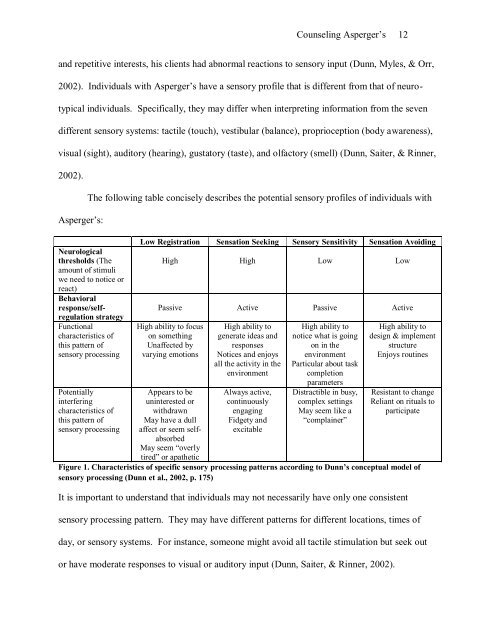COUNSELING ADULTS WITH ASPERGER‟S - School of Health ...
COUNSELING ADULTS WITH ASPERGER‟S - School of Health ...
COUNSELING ADULTS WITH ASPERGER‟S - School of Health ...
Create successful ePaper yourself
Turn your PDF publications into a flip-book with our unique Google optimized e-Paper software.
Counseling Asperger‟s 12<br />
and repetitive interests, his clients had abnormal reactions to sensory input (Dunn, Myles, & Orr,<br />
2002). Individuals with Asperger‟s have a sensory pr<strong>of</strong>ile that is different from that <strong>of</strong> neuro-<br />
typical individuals. Specifically, they may differ when interpreting information from the seven<br />
different sensory systems: tactile (touch), vestibular (balance), proprioception (body awareness),<br />
visual (sight), auditory (hearing), gustatory (taste), and olfactory (smell) (Dunn, Saiter, & Rinner,<br />
2002).<br />
Asperger‟s:<br />
The following table concisely describes the potential sensory pr<strong>of</strong>iles <strong>of</strong> individuals with<br />
Neurological<br />
thresholds (The<br />
amount <strong>of</strong> stimuli<br />
we need to notice or<br />
react)<br />
Behavioral<br />
response/self-<br />
regulation strategy<br />
Functional<br />
characteristics <strong>of</strong><br />
this pattern <strong>of</strong><br />
sensory processing<br />
Potentially<br />
interfering<br />
characteristics <strong>of</strong><br />
this pattern <strong>of</strong><br />
sensory processing<br />
Low Registration Sensation Seeking Sensory Sensitivity Sensation Avoiding<br />
High<br />
Passive<br />
High ability to focus<br />
on something<br />
Unaffected by<br />
varying emotions<br />
Appears to be<br />
uninterested or<br />
withdrawn<br />
May have a dull<br />
affect or seem selfabsorbed<br />
May seem “overly<br />
tired” or apathetic<br />
High<br />
Active<br />
High ability to<br />
generate ideas and<br />
responses<br />
Notices and enjoys<br />
all the activity in the<br />
environment<br />
Always active,<br />
continuously<br />
engaging<br />
Fidgety and<br />
excitable<br />
Low<br />
Passive<br />
High ability to<br />
notice what is going<br />
on in the<br />
environment<br />
Particular about task<br />
completion<br />
parameters<br />
Distractible in busy,<br />
complex settings<br />
May seem like a<br />
“complainer”<br />
Low<br />
Active<br />
High ability to<br />
design & implement<br />
structure<br />
Enjoys routines<br />
Resistant to change<br />
Reliant on rituals to<br />
participate<br />
Figure 1. Characteristics <strong>of</strong> specific sensory processing patterns according to Dunn’s conceptual model <strong>of</strong><br />
sensory processing (Dunn et al., 2002, p. 175)<br />
It is important to understand that individuals may not necessarily have only one consistent<br />
sensory processing pattern. They may have different patterns for different locations, times <strong>of</strong><br />
day, or sensory systems. For instance, someone might avoid all tactile stimulation but seek out<br />
or have moderate responses to visual or auditory input (Dunn, Saiter, & Rinner, 2002).


